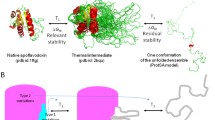Abstract
The region between the amino acids 31-46 was previously identified as being first exposed during thermal unfolding of bovine pancreatic ribonuclease A (RNase). The exchange of one amino acid (Leu35toSer) in this unfolded region of RNase is shown to have a dramatic destabilizing effect (ΔTm=9 °C). Antibodies raised against a peptide corresponding to the sequence of the labile region, S32-V43, of RNase were effective in stabilizing L35S-RNase against thermal inactivation (65 °C for 2 h) and surpassed the stabilization effect of antiRNase antibodies. An 11% contribution to the stabilizing effect of antiRNase antibodies resulted from antibodies recognizing the unfolding region of the enzyme.
Similar content being viewed by others
References
Arnold U, Rücknagel KP, Schierhorn A, Ulbrich-Hofmann R (1996) Thermal unfolding and proteolytic susceptibility of ribonuclease A. Eur. J. Biochem. 237: 862-869.
Arnold U, Ulbrich-Hofmann R (1999) Quantitative protein precipitation from guanidine hydrochloride-containing solutions by sodium deoxycholate/trichloroacetic acid. Anal. Biochem. 27: 197-199.
Curtis PJ, Burdon MG, Smellie RMS (1966) The purification from rat liver of a nuclease hydrolysing ribonucleic acid and deoxyribonucleic acid. Biochem. J. 8: 813-817.
delCardayré SB, Ribo M, Yokel EM, Quirk DJ, Rutter WJ, Raines RT (1995) Engineering ribonuclease A: production, purification and characterization of wild-type enzyme and mutant at Gln11. Protein Eng. 8: 261-273.
Fágáin CÓ (1995) Understanding and increasing protein stability. Biochim. Biophys. Acta 1252: 1-14.
Jafri F, Saleemuddin M (1997) Immobilization of invertase on Sepharose-linked enzyme glycosyl recognizing polyclonal antibodies. Biotechnol. Bioeng. 55: 605-609.
Markert Y, Köditz J, Mansfeld J, Arnold U, Ulbrich-Hofmann R (2001) Increased proteolytic resistance of ribonuclease A by protein engineering. Protein Eng. 14: 101-106.
Saleemuddin M (1999) Bioaffinity based immobilization of enzymes. Adv. Biochem. Eng. Biotechnol. 64: 203-226. 1826
Solomon B, Hollander Z, Koppel R, Katchalski-Katzir E (1987) Use of monoclonal antibodies for the preparation of highly active immobilized enzymes. Meth. Enzymol. 135: 160-170.
Solomon B, Koppel R, Hanan E, Katzav T (1996) Monoclonal antibodies inhibit in vitro fibrillar aggregation of the Alzheimer β-amyloid peptide. Proc. Natl. Acad. Sci. USA 93: 452-455.
Turková J (1999) Oriented immobilization of biologically active proteins as a tool for revealing protein interaction and function. J. Chromatogr. B 722: 11-31.
Younus H, Owais M, Rao DN, Saleemuddin M (2001) Stabilization of pancreatic ribonuclease A by immobilization on Sepharoselinked antibodies that recognize the labile region of the enzyme. Biochim. Biophys. Acta 1548: 114-120.
Author information
Authors and Affiliations
Rights and permissions
About this article
Cite this article
Younus, H., Köditz, J., Saleemuddin, M. et al. Selective stabilization of a labile mutant form of bovine pancreatic ribonuclease A by antibodies. Biotechnology Letters 24, 1821–1826 (2002). https://doi.org/10.1023/A:1020642112487
Issue Date:
DOI: https://doi.org/10.1023/A:1020642112487




